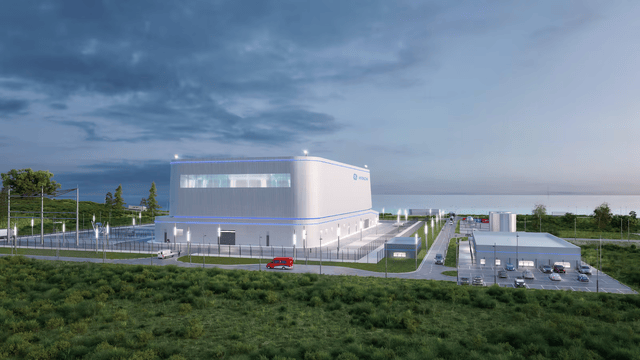
An artist rendering of the first small modular reactor (SMR) being built in Ontario. (Source: Ontario Power Generation)
Canada is taking a giant leap in clean energy. Ontario will soon begin building the G7’s first small modular nuclear reactors (SMRs), a decision that could shape the future of global power production.
A New Era of Compact Nuclear Power
For over a decade, SMRs have been discussed as the future of nuclear energy. Now, they’re becoming a reality. Ontario Power Generation (OPG) is investing $7.7 billion into constructing the first of four SMRs near the Darlington nuclear station, just east of Toronto.
These reactors are significantly smaller than traditional nuclear plants but operate on the same principle—nuclear fission. The technology produces heat, which is converted into electricity.
According to Brendan Frank from Clean Prosperity, a climate-focused non-profit, “SMRs are essentially scaled-down versions of traditional plants. They’re about a third or a quarter of the size.”
Meet the BWRX 300 Reactor
The new reactors, designed by U.S.-based GE Hitachi Nuclear Energy, are called the BWRX 300. Each reactor can generate 300 megawatts of electricity—enough to power 300,000 homes. The first unit is expected to go online by 2030, with all four operational by 2035.
The full SMR project will cost nearly $21 billion. It’s expected to create 18,000 jobs and involve over 80 Ontario-based companies. The reactors are projected to run for 65 years.
Ontario's energy minister, Stephen Lecce, calls the move “a bold decision” that will help meet rising electricity demand. By 2050, the province expects demand to rise by 75%.
Eyes on Ontario: Other Provinces Consider SMRs
Ontario’s SMR project could set a global example. Provinces like Saskatchewan, Alberta, and New Brunswick are closely watching its progress.
“Saskatchewan is seriously considering the same reactor design,” said Frank. “Their final decision depends heavily on how Ontario’s rollout performs.”
The compact, modular design of SMRs makes them ideal for remote areas where large-scale infrastructure isn’t feasible.
Global Impact and Economic Potential
Ontario is not just looking inward. It’s actively working to export SMR technology to international markets like Poland and Estonia.
Frank sees this as part of a bigger picture: “There’s a global goal to triple nuclear capacity by 2050. Canada has a chance to play a major role in that expansion while boosting job creation and economic growth at home.”
Not Everyone Is on Board
Despite the excitement, the project has sparked criticism. Jack Gibbons of the Ontario Clean Air Alliance argues that solar and wind offer more cost-effective solutions.
He also raises national security concerns about relying on American technology. “These reactors require enriched uranium from the U.S.,” said Gibbons. “That supply could be cut off if Donald Trump becomes president again.”
A Risk Worth Taking?
While critics voice concerns, supporters believe SMRs are key to a clean and stable energy future. The outcome of Ontario’s project will likely influence energy strategies across Canada and beyond.
Whether SMRs prove to be a game-changer or a costly gamble remains to be seen. But for now, Canada is leading the charge in the next generation of nuclear innovation.















